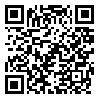BibTeX | RIS | EndNote | Medlars | ProCite | Reference Manager | RefWorks
Send citation to:
URL: http://jdisabilstud.org/article-1-714-en.html
2- Assistant Professor, Faculty of Psychology and Educational Sciences, University of Isfahan, Isfahan, Iran
3- Associate Professor of Children with Special Needs, Department of Children With Special Needs, University of Isfahan, Isfahan, Iran
4- Professor of Islamic Azad University, Isfahan (Khorasgan) branch, Isfahan, Iran
Abstract
Objective: This study compared the effects of the Independent Local Learning Program (ILLP) and Pintrich's Self–regulated Learning Model (SRLM) on test anxiety in high school female students.
Methods: This research was an applied and quasi–experimental study with a pretest–posttest design and a control group. The selected samples were divided into 3 groups (2 experimental and 1 control). This study explored the effects of implementing ILLP and Pintrich's SRLM among high school students. The study's statistical population included all female high school students in Tehran City, Iran, in the academic year 2014–2015. A multi–stage cluster and purposive sampling method were used to select the study samples. Accordingly, two districts (out of 22 educational districts) of Tehran and two high schools (out of 6) were randomly selected. Subsequently, 45 students were randomly selected and divided into 3 study groups (n=15/group). The Test Anxiety Scale (TAS) was used to measure test anxiety in the study subjects. TAS is a self–report tool developed by Sarason (1987) and includes 25 sentences answered on a yes/no scale. The maximum and minimum obtainable scores were 25 and 0, indicating intense and no anxiety, respectively. Furthermore, scores <8 and >12 reflect mild and high anxiety, respectively. Concerning the validity and reliability of the questionnaire, the internal consistency coefficient of this scale was calculated as 0.91 by the test–retest method. Also, its test–retest coefficient with a 6–week interval was reported as 0.86. The reliability coefficient of this scale was estimated to be 88.8, and its Cronbach alpha coefficient equaled 0.87. The other questionnaire used in the study was the Self–Regulated Learning Questionnaire (SRLQ), which has 47 items and two sections: motivational beliefs and self–regulatory learning strategies (cognitive and metacognitive strategies). Using cognitive and metacognitive strategies, the reliability coefficients of self–efficacy, internal evaluation, and test anxiety subscales were computed as 89%, 87%, 75%, 83%, and 74%, respectively. The other study tool was the Commonwealth of Learning Curriculum Questionnaire (86 questions), aimed at assessing learning strategies and their dimensions (repeating or reviewing simple and basic assignments, repeating, or reviewing complex assignments, developing a special semantic of simple and basic assignments, developing the special meaning of complex tasks, organizing special simple homework assignments, organizing special simple complex assignments, knowledge and control [commitment, attitude, and attention], knowledge and process control, planning, knowledge and control of the process of control and evaluation, knowledge and process control–order, repeat or review, semantic expansion, organization overall, knowledge and self–control, and process control knowledge, cognitive and metacognitive). The test–retest reliability using Cronbach alpha coefficient for this scale equaled 0.98–0.94. This study employed ILLP and SRLM. The former is a self–regulated learning program that addresses various factors and modules respecting self–regulation. Each effective learning component is part of a dynamic system that continuously and mutually influences other characteristics in the independent learning system. The author provided the curriculum of workshops and training in independent learning. It included 7 worksheets. Pintrich's SRLM is self–regulatory learning that involves strategies for setting cognitive processes or managing strategies for learners to curb their learning process.
Results: The effects of ILLP were not significant on test anxiety (F=2.35, p=0.136) at the significant level of 0.05. The impact of ILLP and Pintrich's SRLM was significant on test anxiety (F=7.254 and p=0.002); the test anxiety variance in the experimental and control groups was significantly different at the significant level of 0.05. According to the Dunn test, the ILLP group with the lowest mean presented higher effectiveness than the SRLM group in students' test anxiety (p=0.019).
Conclusion: ILLP presented a more significant impact on students' test anxiety compared to Pintrich's SRLM. Thus, ILLP could be used to reduce students' test anxiety. Additionally, using ILLP could reduce students' test anxiety and subsequently improve their academic performance.
| Rights and permissions | |
 |
This work is licensed under a Creative Commons Attribution-NonCommercial 4.0 International License. |





